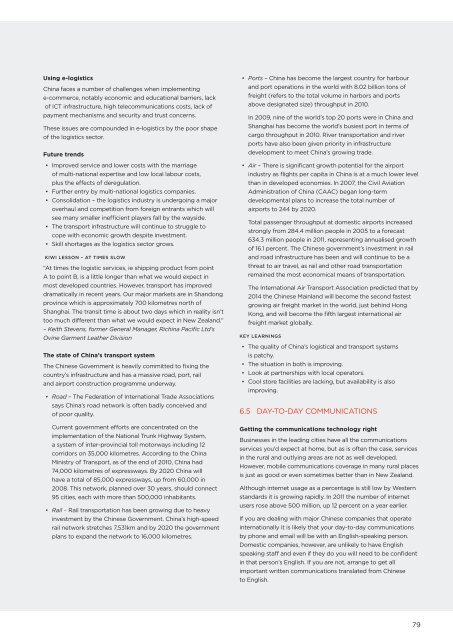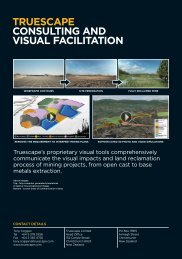Navigating China Guide (2012) - New Zealand Trade and Enterprise
Navigating China Guide (2012) - New Zealand Trade and Enterprise
Navigating China Guide (2012) - New Zealand Trade and Enterprise
Create successful ePaper yourself
Turn your PDF publications into a flip-book with our unique Google optimized e-Paper software.
Using e-logistics<br />
<strong>China</strong> faces a number of challenges when implementing<br />
e-commerce, notably economic <strong>and</strong> educational barriers, lack<br />
of ICT infrastructure, high telecommunications costs, lack of<br />
payment mechanisms <strong>and</strong> security <strong>and</strong> trust concerns.<br />
These issues are compounded in e-logistics by the poor shape<br />
of the logistics sector.<br />
Future trends<br />
• Improved service <strong>and</strong> lower costs with the marriage<br />
of multi-national expertise <strong>and</strong> low local labour costs,<br />
plus the effects of deregulation.<br />
• Further entry by multi-national logistics companies.<br />
• Consolidation – the logistics industry is undergoing a major<br />
overhaul <strong>and</strong> competition from foreign entrants which will<br />
see many smaller inefficient players fall by the wayside.<br />
• The transport infrastructure will continue to struggle to<br />
cope with economic growth despite investment.<br />
• Skill shortages as the logistics sector grows.<br />
KIWI LESSON – AT TIMES SLOW<br />
“At times the logistic services, ie shipping product from point<br />
A to point B, is a little longer than what we would expect in<br />
most developed countries. However, transport has improved<br />
dramatically in recent years. Our major markets are in Sh<strong>and</strong>ong<br />
province which is approximately 700 kilometres north of<br />
Shanghai. The transit time is about two days which in reality isn’t<br />
too much different than what we would expect in <strong>New</strong> <strong>Zeal<strong>and</strong></strong>.”<br />
– Keith Stevens, former General Manager, Richina Pacific Ltd’s<br />
Ovine Garment Leather Division<br />
The state of <strong>China</strong>’s transport system<br />
The Chinese Government is heavily committed to fixing the<br />
country’s infrastructure <strong>and</strong> has a massive road, port, rail<br />
<strong>and</strong> airport construction programme underway.<br />
• Road – The Federation of International <strong>Trade</strong> Associations<br />
says <strong>China</strong>’s road network is often badly conceived <strong>and</strong><br />
of poor quality.<br />
Current government efforts are concentrated on the<br />
implementation of the National Trunk Highway System,<br />
a system of inter-provincial toll motorways including 12<br />
corridors on 35,000 kilometres. According to the <strong>China</strong><br />
Ministry of Transport, as of the end of 2010, <strong>China</strong> had<br />
74,000 kilometres of expressways. By 2020 <strong>China</strong> will<br />
have a total of 85,000 expressways, up from 60,000 in<br />
2008. This network, planned over 30 years, should connect<br />
95 cities, each with more than 500,000 inhabitants.<br />
• Rail – Rail transportation has been growing due to heavy<br />
investment by the Chinese Government. <strong>China</strong>’s high-speed<br />
rail network stretches 7,531km <strong>and</strong> by 2020 the government<br />
plans to exp<strong>and</strong> the network to 16,000 kilometres.<br />
• Ports – <strong>China</strong> has become the largest country for harbour<br />
<strong>and</strong> port operations in the world with 8.02 billion tons of<br />
freight (refers to the total volume in harbors <strong>and</strong> ports<br />
above designated size) throughput in 2010.<br />
In 2009, nine of the world’s top 20 ports were in <strong>China</strong> <strong>and</strong><br />
Shanghai has become the world’s busiest port in terms of<br />
cargo throughput in 2010. River transportation <strong>and</strong> river<br />
ports have also been given priority in infrastructure<br />
development to meet <strong>China</strong>’s growing trade.<br />
• Air – There is significant growth potential for the airport<br />
industry as flights per capita in <strong>China</strong> is at a much lower level<br />
than in developed economies. In 2007, the Civil Aviation<br />
Administration of <strong>China</strong> (CAAC) began long-term<br />
developmental plans to increase the total number of<br />
airports to 244 by 2020.<br />
Total passenger throughput at domestic airports increased<br />
strongly from 284.4 million people in 2005 to a forecast<br />
634.3 million people in 2011, representing annualised growth<br />
of 16.1 percent. The Chinese government’s investment in rail<br />
<strong>and</strong> road infrastructure has been <strong>and</strong> will continue to be a<br />
threat to air travel, as rail <strong>and</strong> other road transportation<br />
remained the most economical means of transportation.<br />
The International Air Transport Association predicted that by<br />
2014 the Chinese Mainl<strong>and</strong> will become the second fastest<br />
growing air freight market in the world, just behind Hong<br />
Kong, <strong>and</strong> will become the fifth largest international air<br />
freight market globally.<br />
KEY LEARNINGS<br />
• The quality of <strong>China</strong>’s logistical <strong>and</strong> transport systems<br />
is patchy.<br />
• The situation in both is improving.<br />
• Look at partnerships with local operators.<br />
• Cool store facilities are lacking, but availability is also<br />
improving.<br />
6.5 DAY-TO-DAY COMMUNICATIONS<br />
Getting the communications technology right<br />
Businesses in the leading cities have all the communications<br />
services you’d expect at home, but as is often the case, services<br />
in the rural <strong>and</strong> outlying areas are not as well developed.<br />
However, mobile communications coverage in many rural places<br />
is just as good or even sometimes better than in <strong>New</strong> <strong>Zeal<strong>and</strong></strong>.<br />
Although internet usage as a percentage is still low by Western<br />
st<strong>and</strong>ards it is growing rapidly. In 2011 the number of internet<br />
users rose above 500 million, up 12 percent on a year earlier.<br />
If you are dealing with major Chinese companies that operate<br />
internationally it is likely that your day-to-day communications<br />
by phone <strong>and</strong> email will be with an English-speaking person.<br />
Domestic companies, however, are unlikely to have English<br />
speaking staff <strong>and</strong> even if they do you will need to be confident<br />
in that person’s English. If you are not, arrange to get all<br />
important written communications translated from Chinese<br />
to English.<br />
79
















